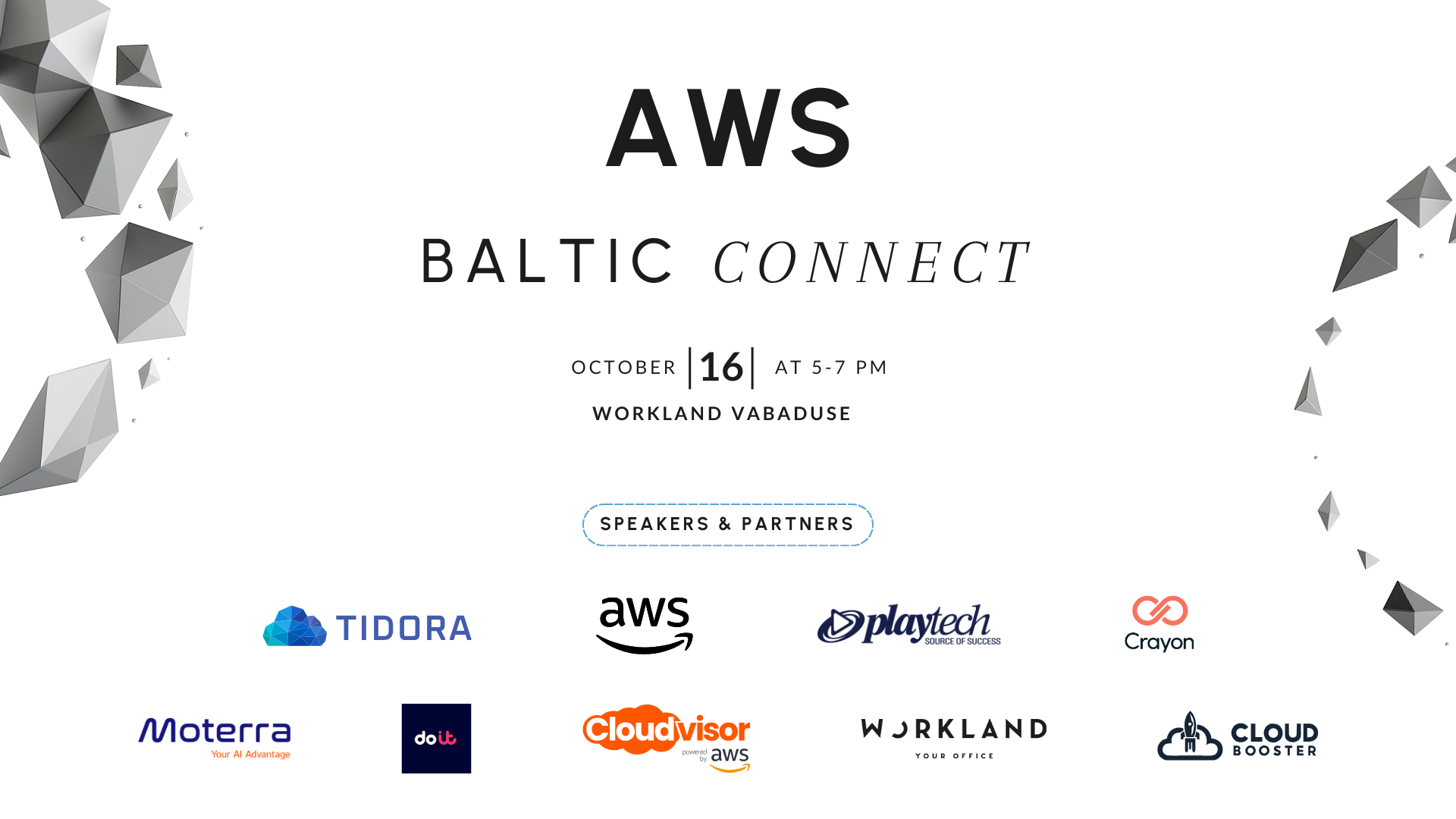From Zero to Cloud Hero: Lessons on Starting with AWS the Right Way
TIDORA’s AWS webinar shared smart adoption tips: start small, secure early, use incentives, avoid pitfalls, and scale with simplicity.
From Zero to Cloud Hero: Lessons on Starting with AWS the Right Way
At TIDORA, we’ve always believed that cloud adoption shouldn’t feel like wrestling with a giant octopus - too many moving parts, plenty of potential pitfalls, and a tendency to get tangled up if you don’t know where to start. That’s why, on July 25th, we hosted a live webinar: “How to Get Started with AWS the Easy Way”, bringing together three experienced voices to guide businesses through the maze of AWS adoption.
Our very own Radek Forgač (CEO & Co-founder of Tidora) was joined by Dominika Pražáková (Account Manager, AWS) and Dominik Snopek (CEO of CloudBooster) to explore not just the “how” of AWS migration, but also the “why,” the “what to avoid,” and the “how to make it faster without breaking things.”
The result? A lively, practical, and sometimes eye-opening conversation about starting small, thinking long-term, and embracing simplicity before complexity.
Why AWS – and Why Start Smart?
AWS has been at the top of Gartner’s Magic Quadrant for cloud platforms for 14 years running. Its track record speaks for itself:
- During COVID-19, Zoom scaled from 10 million to 300 million daily users on AWS.
- BMW connected 15 million cars worldwide using AWS IoT services.
The attraction is obvious: global reach, high availability, and a rich service catalogue. But with hundreds of AWS services on offer, choosing the right starting point matters more than you might think.
As Radek put it early in the session:
“It’s about your product and business using AWS properly so it can bring you the benefits you’re expecting - without overspending or overcomplicating.”
Three Ways to Kick-Off AWS Adoption
Radek outlined three primary approaches to running workloads on AWS, each with its pros and cons:
- Cloud-Native / Serverless
Build your application to take full advantage of AWS-native services from day one. You don’t manage servers; you focus on deploying code. This offers scalability and efficiency but requires deeper developer involvement and a specific architectural mindset from the start. - Containers
If your applications are containerized (Docker, Kubernetes, etc.), AWS has services like Fargate and EKS that make deployment straightforward. This is currently the most common approach and strikes a balance between flexibility and manageability. - Lift-and-Shift (VM-based)
Migrate existing workloads directly into AWS virtual machines. This is fast and familiar but often less cost-efficient and less flexible unless paired with later optimization.
His advice? Be intentional - pick the approach that fits your current workloads and long-term strategy, not just the one that seems easiest in the moment.
Your First 30 Days on AWS: The Crucial Steps
Radek stressed that the first month can make or break a migration. His recommended checklist:
- Define your architecture early
Without a clear target architecture, you risk “zombie resources” (unused but billable services) and messy deployments. - Set up a landing zone
This is your AWS “baseline” - standardized networking, security, and account configurations you can replicate across projects. - Prioritize security from day one
Implement least-privilege IAM policies, enforce multi-factor authentication, and set guardrails to prevent configuration drift. - Start small, then iterate
Test your landing zone and security setup on a small, non-critical workload before rolling out to your entire environment.
Designing for Sustainable Growth
AWS adoption isn’t a one-month project; it’s a long-term relationship. Radek’s tips for scaling without losing control:
- Have an account strategy — know why each AWS account exists and what runs there.
- Plan networking early — avoid future complexity by making informed decisions about how accounts connect.
- Automate operations — embrace Infrastructure as Code (IaC) to speed deployments and ensure consistency.
- Continuously optimize costs — monitor usage, tag resources by product or team, and review pricing plans regularly.
AWS Incentives You Might Be Missing
Dominika’s session focused on the financial and strategic support AWS offers to make adoption easier. Key programs include:
- Proof of Concept (POC) funding — AWS credits to validate an idea before full rollout.
- Migration Acceleration Program (MAP) — up to 25% of your annual AWS spend back in credits during migration.
- AWS Activate — credits and resources for startups.
Her biggest piece of advice:
Talk to AWS or an authorized partner before you start migrating.
Many incentives can’t be applied retroactively once your workloads are already running in AWS.
Common Pitfalls (and How to Avoid Them)
Radek’s second talk zeroed in on what not to do. The top offenders:
- IAM Chaos
Too many admin users, no MFA, and inconsistent access policies can create security risks and compliance nightmares. Fix it with centralized identity management and least-privilege roles. - Cost Surprises
“Zombie” resources, misconfigured networking causing unnecessary traffic charges, and storing everything in expensive tiers are classic budget-busters. Prevent them with tagging, cost monitoring, and storage lifecycle policies. - Lift-and-Shift Illusion
Simply moving existing workloads into AWS without optimization can result in higher costs for minimal benefit. Re-evaluate architecture during migration. - Over-Engineering Early
Chasing multi-cloud or overly complex setups in the first year can slow adoption and balloon costs. Start simple, evolve later.
Automation: The Great Accelerator
Dominik from CloudBooster rounded out the webinar by showing how automation can shrink AWS adoption timelines from months to days.
Four steps to a fast, safe AWS journey:
- Assess current or planned workloads.
- Set up foundational AWS accounts, security, and networking.
- Automate deployments with CI/CD pipelines and Infrastructure as Code.
- Optimize continuously.
CloudBooster’s approach uses ready-made workflow templates - for example, spinning up a full Kubernetes environment with databases and S3 buckets via a guided wizard - reducing time to market and ensuring best-practice configurations from the start.
Real-world results included:
- A fintech startup launching in production within a single sprint (14 days), cutting time to market by 60%.
- A large bank reducing rework by 60% and audit prep time from weeks to hours.
The Big Lessons
From all three speakers, some themes kept coming up:
- Build your landing zone template from day one.
- Tag everything - it’s your best friend for cost control and resource management.
- Share knowledge within your team to standardize how workloads are deployed.
- Centralize IAM - it’s easier to start secure than to fix later.
- Embrace simplicity first, complexity later.
Or as Radek neatly summed up:
“Agile principles apply to infrastructure too. Start simple, iterate often, and don’t over-engineer from the start.”
Final Thoughts
This webinar wasn’t about dazzling people with AWS jargon. It was about showing that AWS adoption can be structured, cost-effective, and even… easy - if you follow the right steps in the right order.
For businesses new to the cloud, the advice was clear:
- Define your goals and architecture.
- Engage AWS and partners early.
- Automate wherever you can.
- Keep costs, security, and simplicity front of mind.
At TIDORA, we help companies move to AWS with these principles baked in from day one - making sure your cloud journey is fast, secure, and sustainable.
If you missed the live session, you can always reach out to us to discuss your AWS plans, pitfalls to avoid, and ways to accelerate your adoption.





